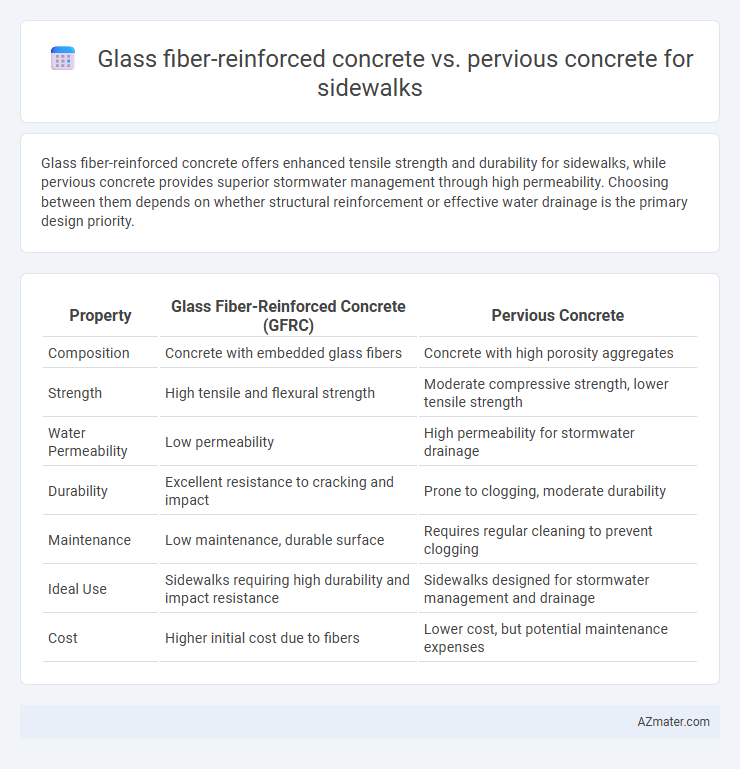Glass fiber-reinforced concrete offers enhanced tensile strength and durability for sidewalks, while pervious concrete provides superior stormwater management through high permeability. Choosing between them depends on whether structural reinforcement or effective water drainage is the primary design priority.
Table of Comparison
| Property | Glass Fiber-Reinforced Concrete (GFRC) | Pervious Concrete |
|---|---|---|
| Composition | Concrete with embedded glass fibers | Concrete with high porosity aggregates |
| Strength | High tensile and flexural strength | Moderate compressive strength, lower tensile strength |
| Water Permeability | Low permeability | High permeability for stormwater drainage |
| Durability | Excellent resistance to cracking and impact | Prone to clogging, moderate durability |
| Maintenance | Low maintenance, durable surface | Requires regular cleaning to prevent clogging |
| Ideal Use | Sidewalks requiring high durability and impact resistance | Sidewalks designed for stormwater management and drainage |
| Cost | Higher initial cost due to fibers | Lower cost, but potential maintenance expenses |
Introduction to Sidewalk Concrete Innovations
Glass fiber-reinforced concrete enhances sidewalk durability by integrating alkali-resistant glass fibers that improve tensile strength and crack resistance, making it ideal for high-traffic areas. Pervious concrete offers superior stormwater management through its porous structure, promoting natural groundwater recharge and reducing runoff. Both innovations address distinct urban infrastructure challenges, optimizing sidewalk performance for longevity and environmental sustainability.
What is Glass Fiber-Reinforced Concrete (GFRC)?
Glass Fiber-Reinforced Concrete (GFRC) is a composite material consisting of a cementitious matrix embedded with alkali-resistant glass fibers, enhancing its tensile strength and durability compared to traditional concrete. GFRC offers superior crack resistance and impact resilience, making it suitable for sidewalks that require long-lasting performance in high-traffic urban environments. This material also provides versatile design options due to its ability to be molded into thin, lightweight panels while maintaining structural integrity.
Understanding Pervious Concrete for Sidewalks
Pervious concrete for sidewalks features a porous structure that allows water to pass through, effectively reducing stormwater runoff and promoting groundwater recharge. Its permeability helps prevent puddling and ice buildup, enhancing pedestrian safety during wet conditions. While glass fiber-reinforced concrete offers increased durability and crack resistance, pervious concrete's environmental benefits make it an ideal choice for sustainable sidewalk applications.
Material Composition and Structure Comparison
Glass fiber-reinforced concrete (GFRC) incorporates alkali-resistant glass fibers within a dense cementitious matrix, enhancing tensile strength and durability through a tightly bonded microstructure. Pervious concrete, composed of cement, coarse aggregates, and minimal fine aggregates, features a porous structure that facilitates water permeability while sacrificing compressive strength and density. The contrasting material compositions produce GFRC with a compact, high-strength framework, whereas pervious concrete offers a porous, permeable network optimized for stormwater management on sidewalks.
Durability and Strength: GFRC vs Pervious Concrete
Glass fiber-reinforced concrete (GFRC) offers superior durability and tensile strength compared to pervious concrete, making it highly resistant to cracking and environmental wear on sidewalks. GFRC's fiber reinforcement enhances its ability to withstand heavy foot traffic and freeze-thaw cycles, while pervious concrete prioritizes water permeability at the expense of compressive strength and long-term durability. For high-traffic sidewalks requiring structural resilience and longevity, GFRC is a more reliable choice than pervious concrete.
Permeability and Water Drainage Capabilities
Glass fiber-reinforced concrete (GFRC) offers enhanced tensile strength and durability but has limited permeability, making it less effective for water drainage compared to pervious concrete. Pervious concrete is engineered with high porosity, allowing water to pass through efficiently, significantly reducing surface runoff and improving groundwater recharge. For sidewalks requiring superior permeability and effective water drainage, pervious concrete is the optimal choice due to its porous structure and enhanced infiltration capacity.
Installation Processes and Considerations
Glass fiber-reinforced concrete (GFRC) requires meticulous mixing to evenly distribute fibers, followed by proper curing to enhance tensile strength and durability, making it ideal for sidewalks subjected to heavy loads and frequent foot traffic. Pervious concrete installation demands careful subgrade preparation and controlled water content to ensure porosity, allowing effective stormwater infiltration and reducing runoff. Both materials require specialized equipment during placement, with GFRC often necessitating spraying or troweling techniques and pervious concrete requiring vibration to maintain open voids for permeability.
Maintenance Requirements and Longevity
Glass fiber-reinforced concrete (GFRC) offers superior durability and lower maintenance requirements compared to pervious concrete, as its dense matrix resists cracking and surface wear, reducing the need for frequent repairs. Pervious concrete, while excellent for stormwater management and permeability, requires routine inspections and cleaning to prevent clogging of its porous structure, which can compromise its longevity. GFRC sidewalks typically last longer under heavy foot traffic and environmental stress due to enhanced tensile strength from glass fibers, whereas pervious concrete may degrade faster if maintenance lapses occur.
Environmental Impact and Sustainability Factors
Glass fiber-reinforced concrete (GFRC) offers enhanced durability and reduced maintenance needs, lowering environmental impact through extended lifespan and decreased resource consumption compared to traditional concrete. Pervious concrete promotes sustainability by allowing stormwater infiltration, reducing runoff, and replenishing groundwater, which mitigates urban heat island effects and supports natural water cycles. Selecting between GFRC and pervious concrete for sidewalks hinges on prioritizing long-term durability versus ecological water management benefits.
Cost Analysis and Practical Applications
Glass fiber-reinforced concrete (GFRC) offers increased tensile strength and durability compared to pervious concrete, which is primarily designed for stormwater management through permeability. GFRC typically incurs higher material and installation costs due to specialized fibers and mixing processes, while pervious concrete tends to be more cost-effective but may require more frequent maintenance to prevent clogging and ensure longevity. In practical applications, GFRC suits sidewalks in high-traffic urban areas demanding robustness and aesthetic versatility, whereas pervious concrete is favored in locations prioritizing environmental benefits and infiltration for sustainable urban drainage systems.

Infographic: Glass fiber-reinforced concrete vs Pervious concrete for Sidewalk
 azmater.com
azmater.com